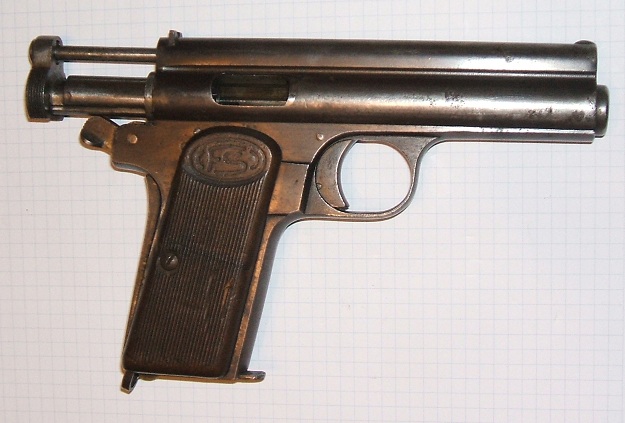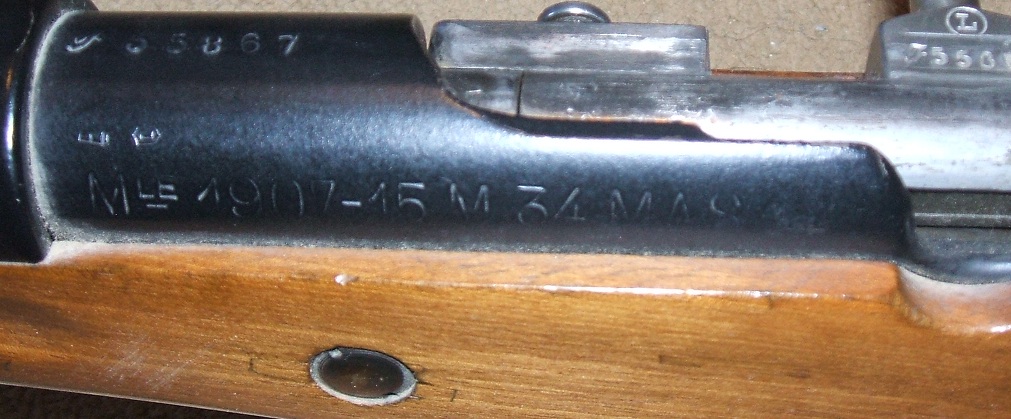It’s a sad fact that there are always a lot more guns for sale than I can afford to buy, and that’s forced be to really think about what guns really hold the most interest for me. And the first thing that really stuck out was “underpriced”. 🙂 But no, there are two major things that can really push me towards buying a gun. The first, as you might have guessed from the fact that I’m running this site, is mechanical oddity.
Guns that are just really weird appeal to me a lot. I just picked up a 1916 Frommer “Stop” (“or else I’ll shoot you again with this little .32!”), entirely because of how funky it is. It’s a long-recoil action (think Browning A5 or Chauchat) squeezed into a little dinky pistol that would have worked perfectly well as a simple straight blowback. If it were release on the market brand new tomorrow, I would have to wonder what the manufacturer was smoking – but somehow they managed to sell a couple hundred thousand of them a hundred years ago, and I jumped at the chance to get one for a good price. When I find one relatively cheap, I’ll buy a Sjogren shotgun for exactly the same reason, even though I’m not much for shooting shotguns.

I also have a real interest in guns with interesting histories. Guns with a long series of modifications, or pieces that were used by 2 or 3 or 4 or more different countries before finally finding their way to the US. For example, I read about an Arisaka that turned up in an import shipment from China. Not just any Arisaka, but on of the guns made under contract for Mexico. It was instead sold to Russia when the contract fell through. Then is was either captured or sold to China and used there, before finally winding up on a ship to the US. Now that would be a neat rifle to have! Similarly, I know somewhere out there is a Mosin-Nagant made in the US by Westinghouse or NEF that was sold to Russia and then captured by Finland.
There are also some guns that are neat for the modifications they have been through. For instance, a Berthier made to the original 1907 pattern that was reworked to the new 1915 spec. Then reworked again to upgrade the 3-round mag to 5 rounds. Then worked over again in 1934 to go to a standard blind magazine and rebarreled for 7.5x54mm.

I could go on – K98k Mausers and MG42s taken from Nazi stockpiles and used by the fledgling Israeli state, Gewehr 88s used in WWI by Germany and then given to Turkey, updated to use spitzer ammo, and then reworked to look like Mausers (complete with a totally useless Mauser bolt disassembly washer in the stock), Vetterli rifles updated every time a European war looked imminent (first single shot, then 3-round magazines, then rebarrel for modern smallbore ammo). They may not appeal to a lot of people, but to me those are the really interesting pieces. “If this rifle could talk…I’d need to learn three new languages to understand its story.”
What do you think? What do you find appealing in a prospective gun purchase?

the british em-2, in the “what could have been” category.
File the EM-2 and the .280 version of the FAL in the “what SHOULD have been” category. Sabotaged by political nonsense.
The Israeli Mausers are very attractive to collectors because of their interesting and ironic history, and their price point is relatively cheap compared to “regular” Mausers. A (sometimes) cheaper option are the many flavors of Mosin Nagant rifles and carbines. This is a great entry military surplus or just entry firearm for many people because of how cheap…err affordable they are. The prices are increasing, especially on the Finn capture and other non-standard MNs, but dollar for dollar they are a great firearm to own, cheap (for now) to shoot, and are equally at fun at the range or in a deer blind. What other large caliber rifle can be had for less than $150, let alone one with such an interesting history?
Anyway, enough of my mini-MN rant. Price is a main factor in gun purchases, along with history, caliber, etc etc. You’d be surprised how many folks have their dads or granddads firearm collecting dust in a closet who would rather it be passed on and used. Start spreading the word amongst friends and friends of friends that you collect old guns, see what gems come out of the woodwork looking for a new home.
Happy hunting!
Yep, I have a bunch of Mosins for exactly those reasons.
I love anything with a story. I have a post WW1 Enfield No. 1 Mk. III* made by BSA. There is no date or anything else on the area under the bolt handle, just “B.S.A Co”. However, it has a South African marking on the barrel (a U with an arrow pointing up in it). It’s obviously been used quite hard, the stock has lots of digs and dents and when I got it there was plenty of dirt in the empty areas of the stock. It has some remnants of red paint on the muzzle cap, so it was probably used as a training rifle. It’s also not import marked.
I would love to know the story of that rifle
I also have a P14 with initials on it. I think it was a British home guard rifle (made by Remington in 1916).
Jordy-
Try posting over at http://www.surplusrifleforum.com/, lots of very knowledgeable folks there who love Enfields.
I had one of those Westinghouse Mosin-Nagant carbines
years ago, according to G&A magazine they were made for the Czar of Russia before the Russian revolution so they kept them here after he was kicked out. Mine was in 8mm mauser not 7.62 rimed
Nice! The 8mm conversions (Polish, I believe) are pretty rare.
I saw one of those Polish 8mm conversions at a gun show a few years ago. I wish I’d bought it, but I had no idea what it was at the time.
How about a 1974 Russian AKM used by Rhodesian (now Zimbabwe) insurgents captured by the Rhodesian Government used by a government soldier then smuggled out of Zimbabwe by it’s owner welded into the frame of a VW combi van to New Zealand. Complete with home made “tiger stripes” i.e. burnt into the laminated stock by the end of a red hot stick. I wish that rifle could have talked!
Yeah, that’s exactly what I’m talking about. 🙂 Got any photos?
I have a Lewis gun that I bought as a dewat. When I rebuilt it I found all the names of the WW2 gun crew engraved on the aluminum shroud. I love that kind of stuff.
I do apologize for the long post, but I think it describes for me why I frequent this site so often and love old guns.
I’ve always been a fan of antiques – my bookshelf has many books written over half a century (and some more than a century) before my birth, I frequently drink from a tea set that was created before my parents were born, most of the firearms I own date to World War II and a humongous portion of my free time is devoted to the study of history. I’m currently a history major in college.
It’s not like this is some new affectation given to me by going to a liberal arts school, either – when I was in kindergarten I was reading 400 page plus books on steam engines and old railway systems. I remember that some of my favorite programs on television were things like Antiques Roadshow, Tales of the Gun and Modern Marvels. History and antiques have always been something that I’ve loved, and despite how much I obsess over them it’s hard to describe to people why that is.
Much of it, like you said, is the story behind things. Sure, I know nothing about the actual history of my 1942 Izhevsk M91/30 Mosin-Nagant, and it’s hardly rare. But I like the image of a conscript in a foxhole, with nothing but this rifle between him and the armies of fascism. Sometimes things I have that I love have a more personal story, such as the mid-1800’s German bible that came over with my family when they emigrated.
But a lot of it is I just like things that are old, and there’s no real good reason why I prefer them to things that are new.
I listen to NPR quite often, and one of my favorite contributors is the author David Sedaris. In his book, “When You Are Engulfed In Flames”, he has a chapter talking about renting a room in a house filled with old trinkets – and he loved it. Things dating from the 1920’s were everywhere (this was probably in the 1980’s), and he was in a world surrounded by the antique. The following quote is probably the best explanation I’ve ever seen as to why some of us just love things from before our own time.
“What I could never fathom, and still can’t, really, is that at one point all those things were new. The wheezing Victrola, the hulking davenport – how were they any different from the eight-track player or my parents’ Scandinavian dining room set? Given enough time, I guess anything can look good. All it has to do is survive.”
Given when your Mosin was made, it’s a safe bet that it saw serious combat.
In 1943, my uncle, then a merchant mariner on a Sun Oil Tanker, swapped two bottles of good Scotch to a young Lieutenant for an M1 Carbine that he had “lost in combat”. 50 years later it came out of his closet and into my sweaty clutching fingers. Flat-top bolt, “I” cut stock type, 1 barrel band, sparkling barrel bore, barrel dated 12-42, and a six-digit serial number,push-button safety…and that first digit is the number 1. Not too unusual, other than the fact that it never went back to Anniston for rebuilding after WWII. I love my carbine!
I like the history and the mechanisms. I’ve purchased guns just so I could take them apart to see how they work (I have a Frommer Stop for instance). Military arms have both history and almost every mechanical variation ever so they are a double win. Old machine tools, old farm tractors (I have 8, the newest from 1945), old stationary engines, cameras, etc. Examples of developing technology all. Knowledge of history of arms and manufacturing gives one a picture of the world you don’t get from any college.
speaking of interesting guns, i found this on the net :
http://www.icollector.com/Exceptional-Experimental-Mauser-Sheet-Metal-Semi-Automatic-Rifle_i9753253
its supposed to be made of sheet metal, except the barrel and buttplate.
maybe you guys can do an article on this.
Actually, we have done a video on that very rifle: https://www.forgottenweapons.com/gerat-03-video/
“I know somewhere out there is a Mosin-Nagant made in the US by Westinghouse or NEF that was sold to Russia and then captured by Finland.”
Here just might be one like that:
http://www.laatuase.fi/en/rifles-license-required/military-rifles/jalkavaenkivaari-m-1891-westinghouse-kal-7-62x53r
the description states:
arsenal repaired=Finnish stock
“Similarly, I know somewhere out there is a Mosin-Nagant made in the US by Westinghouse or NEF that was sold to Russia and then captured by Finland.”
Yup, I know exactly where that Westinghouse is. 😀
Heh…since writing this post, I’ve actually picked up one myself too. 🙂